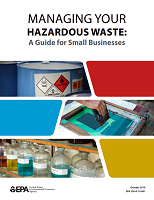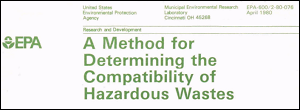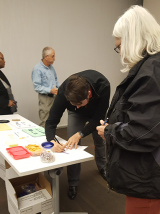Pharma Rule
-
Bans all sewering of hazardous waste pharmaceuticals
- Modifies the listing for nicotine waste (P075)
- Provides expanded options for managing waste pharmaceuticals
EPA Workshops
To help prepare users for the new rule, EPA hosted 12 free Compliance Assistance Workshops throughout Iowa in October and November 2019. These workshops were available to any business that generates waste pharmaceuticals (retail, clinics, hospitals, pharmacies, doctors, veterinarians, long-term care facilities, etc.).
Eight of the workshops were tailored to Very Small Quantity Generators of hazardous waste, and four were Standard Workshops.
 If you know a professional association (e.g., Leading Age or Iowa Pharmacy Association) or regional entity (e.g., chamber of commerce) that is interested in having a compliance assistance workshop tailored to their specific needs, please contact Marcus Rivas at rivas.marcus@epa.gov or 913-551-7669.
If you know a professional association (e.g., Leading Age or Iowa Pharmacy Association) or regional entity (e.g., chamber of commerce) that is interested in having a compliance assistance workshop tailored to their specific needs, please contact Marcus Rivas at rivas.marcus@epa.gov or 913-551-7669.
Web Resources
 EPA Memo Authorizing Hazardous Waste Code PHRM on Uniform Hazardous Waste Manifest (PDF)(2 pp, 1.02 MB, About PDF) – EPA issued this memo in December 2019 regarding the use of the PHARMS code on the Manifest, as required by the Pharmaceuticals Rule, for shipments of non-creditable hazardous waste pharmaceuticals from health care facilities. The federal regulation requires health care facilities to write PHARMS in Item 13 of the Manifest. However, a number of states and members of the regulated community expressed concerns about having to implement a six-character federal waste code when most codes are four characters. EPA held additional consultations and reached a mutual decision to implement an alternate four-character code (PHRM) that will also satisfy the requirement. Therefore, health care facilities may use either PHARMS or PHRM in Item 13 of the Manifest. The PHRM code is live in the e-Manifest System and can be used immediately on electronic Manifests. The memo also clarifies that additional waste codes are allowed to be entered on the Item 13, but they are not required.
EPA Memo Authorizing Hazardous Waste Code PHRM on Uniform Hazardous Waste Manifest (PDF)(2 pp, 1.02 MB, About PDF) – EPA issued this memo in December 2019 regarding the use of the PHARMS code on the Manifest, as required by the Pharmaceuticals Rule, for shipments of non-creditable hazardous waste pharmaceuticals from health care facilities. The federal regulation requires health care facilities to write PHARMS in Item 13 of the Manifest. However, a number of states and members of the regulated community expressed concerns about having to implement a six-character federal waste code when most codes are four characters. EPA held additional consultations and reached a mutual decision to implement an alternate four-character code (PHRM) that will also satisfy the requirement. Therefore, health care facilities may use either PHARMS or PHRM in Item 13 of the Manifest. The PHRM code is live in the e-Manifest System and can be used immediately on electronic Manifests. The memo also clarifies that additional waste codes are allowed to be entered on the Item 13, but they are not required.
 EPA Region 7’s Hazardous Waste Pharmaceutical Inspection Checklist, Jan 2020 (PDF)(15 pp, 466 K, About PDF) – This module is a unit within EPA Region 7’s Standard Operating Procedure for hazardous waste inspections. In particular, this module is for compliance with the hazardous waste pharmaceutical management regulations found in 40 Code of Federal Regulations (CFR) part 266 subpart P.
EPA Region 7’s Hazardous Waste Pharmaceutical Inspection Checklist, Jan 2020 (PDF)(15 pp, 466 K, About PDF) – This module is a unit within EPA Region 7’s Standard Operating Procedure for hazardous waste inspections. In particular, this module is for compliance with the hazardous waste pharmaceutical management regulations found in 40 Code of Federal Regulations (CFR) part 266 subpart P.
 NIOSH List of Antineoplastic and Other Hazardous Drugs in Healthcare Settings, 2016 – NIOSH List of The National Institute for Occupational Safety and Health (NIOSH) Alert, "Preventing Occupational Exposures to Antineoplastic and Other Hazardous Drugs in Health Care Settings," published in September 2004, identified a sample list of major hazardous drugs. The list was compiled from information provided by four institutions that generated their own lists of hazardous drugs, as well as a list from the Pharmaceutical Research and Manufacturers of America (PhRMA). The 2004 list was updated in 2010, 2012 and 2014, and is updated every two years. This 2016 update added 34 drugs and includes a review of the 2004 list. NIOSH updated its list of hazardous drugs for 2016, which includes drugs reviewed by NIOSH from January 2012 to December 2013. (Note: This is the list of “hazardous drugs,” which is not exactly the same concept as RCRA Hazardous Waste.) Learn more about the list
NIOSH List of Antineoplastic and Other Hazardous Drugs in Healthcare Settings, 2016 – NIOSH List of The National Institute for Occupational Safety and Health (NIOSH) Alert, "Preventing Occupational Exposures to Antineoplastic and Other Hazardous Drugs in Health Care Settings," published in September 2004, identified a sample list of major hazardous drugs. The list was compiled from information provided by four institutions that generated their own lists of hazardous drugs, as well as a list from the Pharmaceutical Research and Manufacturers of America (PhRMA). The 2004 list was updated in 2010, 2012 and 2014, and is updated every two years. This 2016 update added 34 drugs and includes a review of the 2004 list. NIOSH updated its list of hazardous drugs for 2016, which includes drugs reviewed by NIOSH from January 2012 to December 2013. (Note: This is the list of “hazardous drugs,” which is not exactly the same concept as RCRA Hazardous Waste.) Learn more about the list
 Managing Your Hazardous Waste: A Guide for Small Businesses – This guide provides an overview of the federal hazardous waste management regulations and helps small business owners and operators understand how best to comply with those regulations. It was updated to incorporate new requirements, including the Hazardous Waste Generator Improvements Rule, e-Manifest rules, and Hazardous Waste Pharmaceuticals Rule. Available in multiple translated versions, including Chinese, Korean, Russian, Spanish, Vietnamese and Tagalog.
Managing Your Hazardous Waste: A Guide for Small Businesses – This guide provides an overview of the federal hazardous waste management regulations and helps small business owners and operators understand how best to comply with those regulations. It was updated to incorporate new requirements, including the Hazardous Waste Generator Improvements Rule, e-Manifest rules, and Hazardous Waste Pharmaceuticals Rule. Available in multiple translated versions, including Chinese, Korean, Russian, Spanish, Vietnamese and Tagalog.
 Healthcare Environmental Resource Center – HERC provides pollution prevention and environmental compliance assistance information for the health care sector. It is intended to be a comprehensive resource, covering all the varieties of hospital wastes and all the rules that apply to them, including both federal regulations and the specific rules that apply in your state. HERC also includes environmental compliance information for dental offices and assisted living/nursing care communities, and Managing Pharmaceutical Waste: A 10-Step Blueprint for Healthcare Facilities in the United States. The value of this “Blueprint” cannot be understated. While it predates the Pharmaceutical Rule, the compliance assistance steps remain extremely useful – in particular, Step 2 relating to hazardous waste determinations, Step 5 regarding waste minimization, and Step 7 regarding labeling.
Healthcare Environmental Resource Center – HERC provides pollution prevention and environmental compliance assistance information for the health care sector. It is intended to be a comprehensive resource, covering all the varieties of hospital wastes and all the rules that apply to them, including both federal regulations and the specific rules that apply in your state. HERC also includes environmental compliance information for dental offices and assisted living/nursing care communities, and Managing Pharmaceutical Waste: A 10-Step Blueprint for Healthcare Facilities in the United States. The value of this “Blueprint” cannot be understated. While it predates the Pharmaceutical Rule, the compliance assistance steps remain extremely useful – in particular, Step 2 relating to hazardous waste determinations, Step 5 regarding waste minimization, and Step 7 regarding labeling.
 List of Lists – This is a consolidated list of chemicals subject to reporting requirements under the Emergency Planning and Community Right-to-Know Act (EPCRA); Comprehensive Environmental Response, Compensation and Liability Act (CERCLA); and Section 112(r) of the Clean Air Act. This document also includes waste stream codes for listed and unlisted hazardous wastes under the Resource Conservation and Recovery Act (RCRA), a list of radionuclides reportable under CERCLA, and the definitions or explanation of chemical categories listed under EPCRA section 313 and CERCLA.
List of Lists – This is a consolidated list of chemicals subject to reporting requirements under the Emergency Planning and Community Right-to-Know Act (EPCRA); Comprehensive Environmental Response, Compensation and Liability Act (CERCLA); and Section 112(r) of the Clean Air Act. This document also includes waste stream codes for listed and unlisted hazardous wastes under the Resource Conservation and Recovery Act (RCRA), a list of radionuclides reportable under CERCLA, and the definitions or explanation of chemical categories listed under EPCRA section 313 and CERCLA.
 A Method for Determining the Compatibility of Hazardous Wastes – This is the document EPA Region 7 inspectors use to help assess waste compatibility. While it’s an older resource, it remains invaluable. Region 7 inspectors still use it routinely. The appendices include an industry index, generic waste names, incompatible binary groups, and case histories.
A Method for Determining the Compatibility of Hazardous Wastes – This is the document EPA Region 7 inspectors use to help assess waste compatibility. While it’s an older resource, it remains invaluable. Region 7 inspectors still use it routinely. The appendices include an industry index, generic waste names, incompatible binary groups, and case histories.

